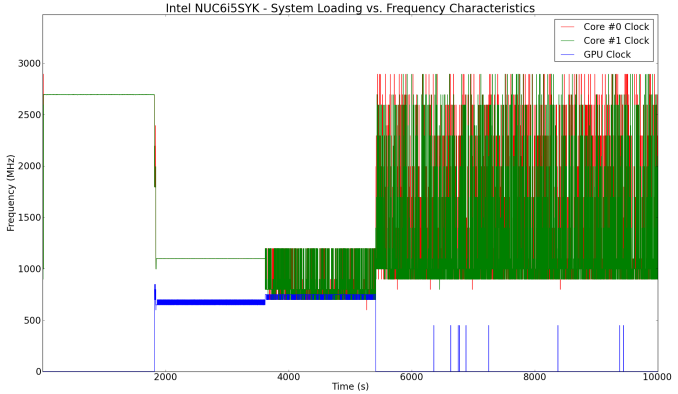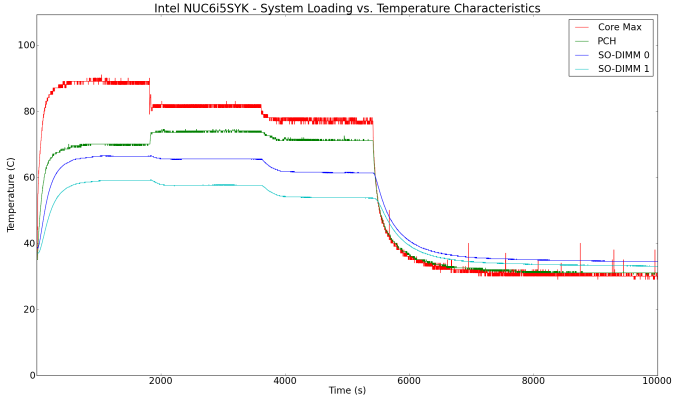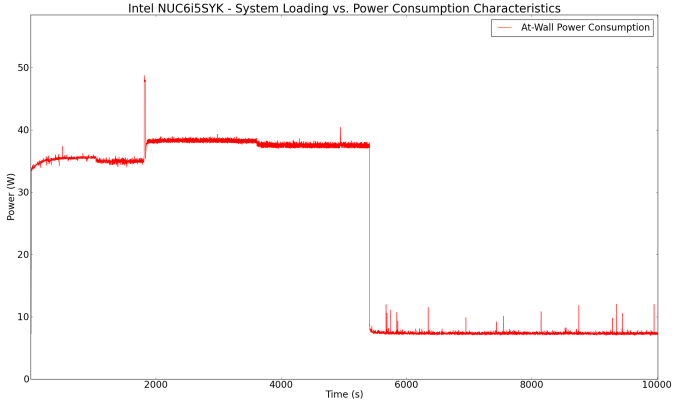The Intel NUC6i5SYK Skylake UCFF PC Review
by Ganesh T S on March 11, 2016 8:00 AM ESTPower Consumption and Thermal Performance
The power consumption of the NUC6i5SYK at the wall was measured with a 1080p display being driven through the HDMI port. In the graphs below, we compare the idle and load power of the Intel NUC6i5SYK with other low power PCs evaluated before. For load power consumption, we ran Furmark 1.12.0 and Prime95 v27.9 together. While the idle power number is consistent with a system sporting a 15W TDP processor, the load power is quite high at 38.37W (considering that the Haswell-based NUCs idled a full 10W lower while also using a 15W TDP processor).


Analyzing the AIDA64 system report and the default BIOS configuration revealed that the unit was optimized for maximum performance. The long duration CPU power limit was set to 23W for a time duration window of 96s and the short duration CPU power limit was set to 30W for 2.44ms. For comparison, the Core i7-6600U in the Surface Book has a long duration CPU limit of 15W for 28s and a short duration limit of 25W for 2.44ms. As we shall see further down in this section, the Core i5-6260U in the NUC6i5SYK doesn't pull back significantly from the 23W limit even under sustained load (despite the 96s configuration).
Moving on to our thermal stress routine, we started with the system at idle, followed by 30 minutes of pure CPU loading. This was followed by another 30 minutes of both CPU and GPU being loaded simultaneously. After this, the CPU load was removed, and the GPU was loaded alone for another 30 minutes. The various clocks in the system as well as the temperatures within the unit are presented below.
We find that the cores spend very little time at the turbo speed of 2.9 GHz, but the steady clock rate is around 2.6 GHz throughout the duration when the CPU was completely loaded. The Core i5-6260U is advertised with a base clock of only 1.8 GHz. There is no throttling at play here even under full CPU load. However, when the GPU gets loaded , the cores drop down to around 1.1 GHz even under load. As we shall see further down, this is probably limited by package power. The GPU cores have a base frequency of 300 MHz (turbo to 950 MHz). Under load, we see it operate between 600 - 700 MHz depending on whether the CPU is loaded simultaneously or not.
According to the official specifications, the junction temperature of the Core i5-6260U is 100C. The thermal solution is more than good enough to maintain the temperature below 90C even under extreme stress. The cores also idle around 33C.
In addition to the frequencies and temperature, we also tracked the power consumption at the wall during the thermal stress testing process. Here, we find that the performance of the system is actually limited by the maximum sustained power consumption limit (around 38W under the tested load conditions) for the system. Irrespective of the CPU and GPU loading, the power consumption is kept under these limits (except for the short spike close to 48W corresponding to the Short Duration Power Limit reported by CPUID).
Since the NUC6i5SYK is not a passively cooled PC, we decided to skip our usual thermal photographs. Given the observed internal temperatures during thermal stress testing and the thermal design (case with adequate number of vents, a blower solution and a plastic lid), we believe that the external case temperatures will not be a cause for concern even under heavy system load.













95 Comments
View All Comments
Spunjji - Saturday, March 12, 2016 - link
I vote you leave the conversationdsumanik - Saturday, March 12, 2016 - link
vote denied.patrickjp93 - Friday, March 11, 2016 - link
Nope, with Skylake Iris = 64MB of eDRAM. Iris Pro = 128MB of eDRAM. You're thinking of Broadwell.damianrobertjones - Friday, March 11, 2016 - link
I have the NUC615SYH model in front of me now with the following:-HyperX Impact 16 GB 2400 MHz
-Samsung 250GB 850 EVO M.2
-Samsung 850 500GB evo 2.5"
All okay, updated to the latest firmward, installed Win10 fine BUT, as is often the case, the auto-driver facility from Intel fails to install a few drivers. You have to manually download and install.
Issues? Yes... The ethernet connection states that there's no internet connection despite being able to get onto the net. No other driver to try at this point in time so I'm using a USB nic.
All in all not bad.
blahsaysblah - Friday, March 11, 2016 - link
NUC5i7RYH- G.SKILL Ripjaws Series 16GB (2 x 8G) 204-Pin DDR3 SO-DIMM DDR3 1866 (PC3 14900)
- Micron M510 M.2 128GB SATA III Internal Solid State Drive (SSD)
- Intel X25M G2 80GB :)
Except for updating BIOS, do NOT install any drivers from Intel. You will get random crashes and issues. Only use what Windows Update gives. Has been rock solid once i did a clean install. Intel's Update tool was broken several months back too. Very surprising that it could not install drivers on a NUC.
From reading the benchmarks, the new 6i5 is a just because release. Unless you really want card reader, but you need a HUB to attack K,M, printer,.. anyway...
I wish they'd gone another direction.
It would be nicer if there was a plain office/developer and non HTPC version. Strip out all the radios, SDXC, HDMI,...
Just
- TPM,
- Lan(dual for VMs would be great),
- DP(1.3 chaining is fine, soon enough real 39"-44" 4k monitors will allow one monitor setups),
- USB (2 USB 2.0: KB,M; 4 USB 3.0: Webcam, printer, UPS, spare; 2 USB 3.0 front: spare, dedicated cellphone charger)
- combined headphone/mic
- 2x M.2 slots. Boot and data. Able to do backups internally. Also for VMs. Running Hyper-V VMs on mine is super smooth.
- the 2.5" drive option is really out of place/ancient. Without it, the bottom plate could be vented instead of sides.
- The removal of radios would allow the cooling solution to be almost doubled in size. I personally have the plastic top removed to allow better cooling.
A non HTPC, office/developer oriented NUC.
TheinsanegamerN - Friday, March 11, 2016 - link
2.5" isnt out of place until M.2 can actually catch up. M.2 is still limited to 512GB drives, and a 512GB m.2 cost more than a 1TB 2.5" SSD. And M.2 runs much hotter than 2.5"blahsaysblah - Friday, March 11, 2016 - link
Having the 5i7 in hand and using it for about 4 months now, the 2.5" is out of place in it. It interferes with cooling of everything on underside. It adds almost 3/4" height to the NUC where it was only 4.53" x 4.37" x 1.26" to begin with.Besides a vented bottom plate allowing the RAM, M.2(air flow is all they need) and other chips much better cooling its really the size issue.
I am running VMs on it with no issue. Taking a tiny NUC with you is much better than a laptop. For all the non-email jobs that require larger display and real keyboard. Again, saying a second non-HTPC line, the HTPC version can be used by folks just doing email.
The 5i7 was only offered in the larger format. I would not have gotten it given a choice. Hibernate, put in pocket. That 3/4" makes huge difference in usability.
Just a different point of view. For developers, engineers you need two internal drives and two M.2 drives are just fine.
kmmatney - Sunday, March 13, 2016 - link
As someone who uses a lot of VMs, I don't see how this is better than a laptop. Needing power, keyboard, mouse, and a monitor any time you need to use it doesn't sound convenient. I'm the opposite extreme, using a 17" laptop and 1.2TB of SSD space - but it's great for running software development VMs anywhere I need it, and I dock it to a 24" monitor in the office.bsly1314 - Monday, March 14, 2016 - link
+1. Furthermore, there seems no enough space to include power-loss protection in M.2 SSD. PLP is important for NUC which, unlike laptops, has no battery to act as backup. I live in third world where the electricity fails about once in a month...watzupken - Friday, March 11, 2016 - link
The real star of the Skylake is the GPU. CPU wise, its not much faster than Broadwell. And quite disappointed in areas where performance actually regress.